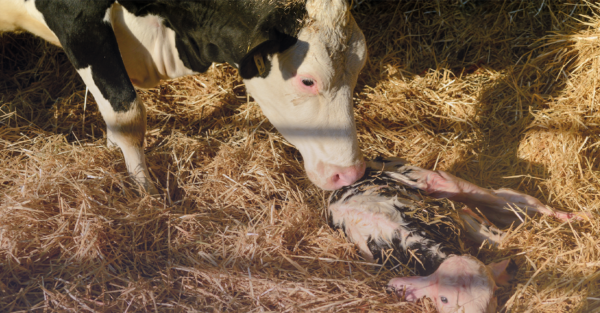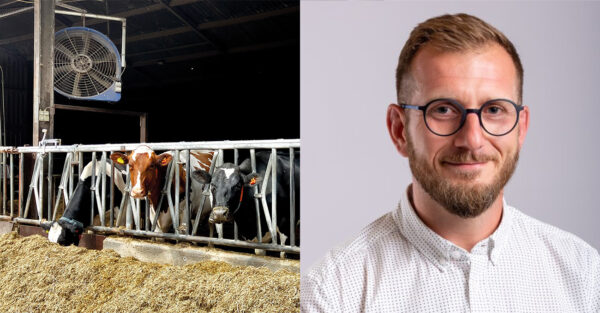Blog | Reading Time 4 minutes
Put ‘the Freeze’ on cold stress productivity dips
When temperatures dip, dairy cows divert their energy to maintaining normal body temperatures. For dairy producers, the switch comes at the expense of milk production. There are simple management tactics to help shield cows from the cold — and keep productivity up.
How cold is too cold?
When it gets cold, cows use more energy for maintenance to help keep warm. Cows naturally can withstand cold weather by growing a thick and dense winter coat, but that takes time. Housing type and environment do play a role. For example, cows may experience less energy loss in a housed free stall with curtains compared to an open corral. The Ontario Ministry of Agriculture in Canada found cold stress can begin between 0° to 7°C depending on coat condition.1 Steep drop in temperatures earlier in the year may affect cows more because their coats just aren’t prepared for winter weather.
Impact on metabolism and milk production
Based on studies and data published in 1981, we now have a better understanding of the responses that lactating dairy cows will exhibit when challenged with cold stress2 (figure 1).
| Air temperature | Maintenance energy | Dry matter intake | Water intake | Daily milk yield |
|---|---|---|---|---|
| 10°C | 100 | 100 | 100 | 100 |
| 5°C | 103 | 100 | 100 | 100 |
| 0°C | 110 | 101 | 96 | 100 |
| -5°C | 118 | 106 | 94 | 100 |
| -10°C | 126 | 109 | 87 | 93 |
| -15°C | 133 | 111 | 82 | 85 |
Figure 1: Relative changes in daily requirements for lactating dairy cows exposed to cold air stress, compared to temperate environmental conditions set at 100% (Adapted from NRC, 1981).
A few interesting biological changes occur under cold temperatures:
- As still air temperatures fall to freezing or below, a cow’s maintenance energy requirements increase by 10 percent or more, to help maintain body temperature. Wind chill would make this scenario worse and require more energy.
- Below freezing, dry matter appetite will improve, generally by 5 to 10 percent in an attempt to “eat more” ration energy.
- Water intakes will decline with cold water.
- With a change in energy partitioning and potential lower water intakes, eventually, average milk yield can decline
Remarkably, the modern dairy cow will continue to maintain milk yield, even with still air temperatures around -5°. Practical experience suggests body condition will be lost to maintain body heat and milk yield.
Some management tips:
- Forage inventories: Have a good handle on the ensiled forage dry matter content on a regular and frequent basis. This ensures there are no surprises on forage-to-grain ratios.
- Allow higher total mixed ration (TMR) refusals: When it gets cold, cows can ramp up dry matter intakes higher than normal refusal allowances. Avoid cows running out of feed at the feed bunk and allow higher TMR refusals for the transition cow pens.
- Watch body condition scores (BCS): A reduction in either BCS or milk protein content can indicate cows are not receiving adequate energy. In particular, watch the fresh cow pen. This group can be vulnerable as they undergo so many changes in the first few days of lactation.
- Check on equipment: Solid ice chunks can get into the mixer wagon and cause damage to knives and other parts. This can affect TMR quality and consistency.
- Monitor waterers: Water intake is important to milk yield. Monitor frozen troughs and other drinking points and make sure water refresh rates are adequate. Cows that receive warm water is a real bonus to keep intake levels high.
- Bedding: The cow’s winter coat is her first protection against the cold. Keep her clean and dry with good bedding. Cow grooming brushes are helpful, too.
- Incorporate feed additives: Wintertime ration changes and increased feed intake can create digestibility challenges. It’s a good idea to include a proven, rumen-specific live yeast such as Saccharomyces cerevisiae CNCM I-1077 (LEVUCELL SC (link to page: https://lallemandanimalnutrition.com/en/europe/our-products/product-details/levucell-sc/) — at all stages of lactation to lower the risk of Sub Acute Ruminal Acidosis (SARA).
Whatever the winter brings, these tips can help offset the productivity losses and protect the herd.
Published Jan 10, 2021 | Updated Dec 4, 2023



